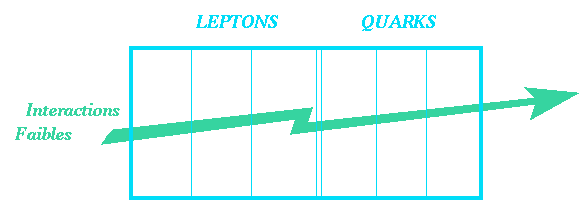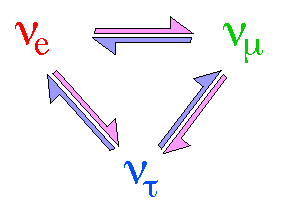
Within the standard model
After many works, mistakes or successes, the particle physicists have finally obtained a model quite satisfying for now, allowing to describe the particles of matter and the way they interact. This model, called "Standard Model", has reduced considerably the number of "elementary elements" the matter is composed of; those elements seems as beautiful as what, near 400 BC, the greek philosopher Democrite was calling "atoms".According to the Standard Model, 12 particles are the base of matter: 6 quarks
(a silly name taken from a James Joyce novel) and 6 leptons (a word coming from the greek
word leptos which means light, tiny).

Apart from the
 neutrino,
all the particles, leptons and quarks, have been put into evidence experimentally,
thanks to particles accelerators and detectors or bubble chambers or both.
Their existence has a very stable experimental fundement.
To each charged lepton (electron, muon, tau) is associated a neutral lepton or
neutrino
(
neutrino,
all the particles, leptons and quarks, have been put into evidence experimentally,
thanks to particles accelerators and detectors or bubble chambers or both.
Their existence has a very stable experimental fundement.
To each charged lepton (electron, muon, tau) is associated a neutral lepton or
neutrino
( for the electron,
for the electron,
 for the muon,
for the muon,
 for the tau).
Same rule for the quarks which are grouped by pairs.
for the tau).
Same rule for the quarks which are grouped by pairs.
Within the standard model, the neutrino has a zero mass, a zero charge and a spin 1/2. It can be of 3 different types or families presented upper. All this is like a directory perfectly ordered. In fact, many important questions concerning the neutrino are still not yet experimentally resolved.

The uncatchable neutrino
The neutrinos, under the three types ,
,
 ,
,
 ,
have kept since 1956 (year of their first experimental evidence) many mysteries.
We know 4 fundamental interactions between the particles:
the strong interaction. the electromagnetic interaction, the weak interaction
and the gravitational interaction.
The neutrinos are only concerned with the weak interaction and this allows to them
to pass through the earth without any deviation or so. They interact at the best
only one time over one billion in the huge apparatus built to detect them.
,
have kept since 1956 (year of their first experimental evidence) many mysteries.
We know 4 fundamental interactions between the particles:
the strong interaction. the electromagnetic interaction, the weak interaction
and the gravitational interaction.
The neutrinos are only concerned with the weak interaction and this allows to them
to pass through the earth without any deviation or so. They interact at the best
only one time over one billion in the huge apparatus built to detect them.
|
Today, in 1996, the three questions of 1956 are still opened:
|
Following is a very short summary of experimental knowledge in 1998 about the neutrino.
| Spin | Mass | Magnetic spin | Cross section on nucleon at 1 GeV | |
 |
1/2 | < 2.8 eV | < 5.8 10-20 MeV/T | about 10-38 cm2 |
 |
1/2 | < 170 keV | < 4.3 10-20 MeV/T | about 10-38 cm2 |
 |
1/2 | < 18.2 MeV | < 3.1 10-17 MeV/T | about 10-38 cm2 |

The incredible neutrino
Moreover, the neutrino seems to have a remarkable property: its spin is always oriented in the direction opposite to its velocity (it is said to be of left helicity). The anti-neutrino is always of right helicity (spin in the same direction as the velocity).This hypothesis was imagined in 1956 by T.D. Lee et C.N. Yang and was confirmed in the following year by Ambler, Hayward, Hoppes, Hudson and Wu, observing an asymmetry of the electrons coming from beta decay of Cobalt 60 nuclei. (Phys. Rev. 105, 1413 (1957)).
If Majorana is right (neutrino identical to the anti-neutrino) or if the neutrino is massive, then the neutrino will not always respect the following observed rule: a neutrino is always left and an anti-neutrino is always right.
With astonishment, we found also this asymmetry in the macroscopic world of life,
where almost all amino-acids are of left chirality,
while ADN uses only right chirality sugars.
The biological phenomena and the the weak interactions are, at first sight, the only physical processes which differ from their mirror image.

The oscillating neutrino:
The quarks composing matter are not independent from each other,
a "quantum mixing" exists between them.
In the same way, the neutrinos
 ,
,
 and
and
 ,
if they were massive, could be mixed by quantum mechanics: a neutrino
traveling in space would then be a mixture of
,
if they were massive, could be mixed by quantum mechanics: a neutrino
traveling in space would then be a mixture of
 ,
,
 and
and
 .
.
This oscillation between neutrino families could help to explain the deficit observed in the solar neutrino flux and could be a good experimental tagging of the fact that neutrinos are massive. Many experiments near nuclear plants or at particles accelerators have tried to explore this way since more than 20 years, in vain up to now. But since 1996, more and more indices in favour of neutrinos oscillation appear.

To access to the neutrino mass by detecting its eventual oscillations is not an easy
task. This indirect measurement depends on two main parameters: the quantum
mixing angle between the concerned
types of neutrinos and the difference of their squared masses.
 and
and

The result of an experiment looking for the neutrinos oscillation is often presented on a plot where is shown
 as a function of
as a function of  .
.
A simple relation gives the probability of oscillation between two types
of neutrinos
(for instance  and
and  )
)

where L is the length (in meters) needed for one oscillation cycle and E is the energy (in MeV) of the neutrinos. You can remark that the lighter is the neutrino, the longer is the oscillation length. Thus, a neutrino
 of mass 0.001 eV/c2, coming from the sun (it has an energy of about 1 MeV)
and oscillating with a neutrino
of mass 0.001 eV/c2, coming from the sun (it has an energy of about 1 MeV)
and oscillating with a neutrino
 of mass 0.1 eV/c2 will become a
of mass 0.1 eV/c2 will become a
 after a travel of 400 meters and will be again a
after a travel of 400 meters and will be again a
 after 800 meters.
after 800 meters.
Last update: 26/06/1999 : http://wwwlapp.in2p3.fr/neutrinos/ankes.html
 Didier Verkindt
Didier Verkindt
 Version francaise
Version francaise